Los Angeles International Airport
| Los Angeles International Airport | |||||||||||||||||||||||
|---|---|---|---|---|---|---|---|---|---|---|---|---|---|---|---|---|---|---|---|---|---|---|---|
 | |||||||||||||||||||||||
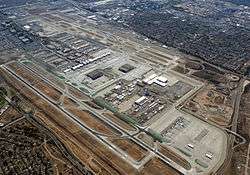 | |||||||||||||||||||||||
|
IATA: LAX – ICAO: KLAX – FAA LID: LAX – WMO: 72295 | |||||||||||||||||||||||
| Summary | |||||||||||||||||||||||
| Airport type | Public | ||||||||||||||||||||||
| Owner | City of Los Angeles | ||||||||||||||||||||||
| Operator | Los Angeles World Airports | ||||||||||||||||||||||
| Serves | Greater Los Angeles Area | ||||||||||||||||||||||
| Location | Los Angeles, California | ||||||||||||||||||||||
| Hub for |
Passenger airlines Cargo airlines | ||||||||||||||||||||||
| Focus city for | |||||||||||||||||||||||
| Elevation AMSL | 128 ft / 39 m | ||||||||||||||||||||||
| Coordinates | 33°56′33″N 118°24′29″W / 33.94250°N 118.40806°WCoordinates: 33°56′33″N 118°24′29″W / 33.94250°N 118.40806°W | ||||||||||||||||||||||
| Website | www.lawa.org | ||||||||||||||||||||||
| Maps | |||||||||||||||||||||||
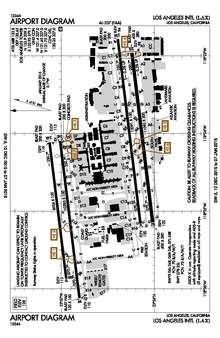 FAA airport diagram | |||||||||||||||||||||||
 LAX  LAX  LAX Location within the Los Angeles metropolitan area | |||||||||||||||||||||||
| Runways | |||||||||||||||||||||||
| |||||||||||||||||||||||
| Statistics | |||||||||||||||||||||||
| |||||||||||||||||||||||
Los Angeles International Airport (IATA: LAX, ICAO: KLAX, FAA LID: LAX) is the largest and busiest airport in the Greater Los Angeles Area and the state of California, as well as being one of the largest international airports in the United States. It is most often referred to by its IATA airport code LAX, with the letters pronounced individually. LAX is located in the southwestern Los Angeles area along the Pacific Ocean between the neighborhood of Westchester to its immediate north and the city of El Segundo to its immediate south. It is owned and operated by Los Angeles World Airports, an agency of the government of Los Angeles, formerly known as the Department of Airports.
In 2015, LAX handled 74,936,256 passengers, an increase of 6 percent from the previous year,[7] making it the seventh busiest airport by passenger traffic in the world. The airport holds the claim for "the world's busiest origin and destination (O & D) airport," and has for many years. The airport also was the third busiest in the world by aircraft movements. Furthermore, it is also the only airport to rank among the top five U.S. airports for both passenger and cargo traffic.[8]
While LAX is the busiest airport in the Greater Los Angeles Area, other airports, including Bob Hope Airport, John Wayne Airport, Long Beach Airport, and Ontario International Airport, also serve the region. It is also notable for being one of the few U.S. airports with four parallel runways.
LAX serves as a hub for Alaska Airlines,[1] American Airlines, Delta Air Lines,[2] United Airlines, and Virgin America. The airport serves as a focus city for Allegiant Air, Air New Zealand, Qantas, Southwest Airlines, Spirit Airlines and Volaris. LAX serves as either a hub or focus city for more Mainline US Carriers than any other airport in the Country and is the only airport that all three legacy carriers have designated a hub.
As the largest international airport on the U.S. West Coast, LAX is a major gateway to and from Europe, Latin America, Asia and Oceania. With its deep connections to Asia and Latin America in particular, LAX is considered to be the premier "Gateway to the Pacific Rim."[9]
History
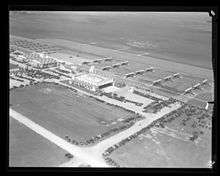

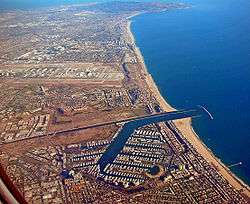
In 1928, the Los Angeles City Council selected 640 acres (1.00 sq mi; 260 ha) in the southern part of Westchester for a new airport for the city. The fields of wheat, barley and lima beans were converted into dirt landing strips without any terminal buildings. It was named Mines Field for William W. Mines, the real estate agent who arranged the deal.[11] The first structure, Hangar No. 1, was erected in 1929 and is in the National Register of Historic Places.[12]
Mines Field opened as the airport of Los Angeles in 1930 and the city purchased it to be a municipal airfield in 1937. The name became Los Angeles Airport in 1941 and Los Angeles International Airport in 1949.[13] In the 1930s the main airline airports were Burbank Airport (then known as Union Air Terminal, and later Lockheed) in Burbank and the Grand Central Airport in Glendale. (In 1940 the airlines were all at Burbank except for Mexicana's three departures a week from Glendale; in late 1946 most airline flights moved to LAX, but Burbank always retained a few.)[14]
Mines Field did not extend west of Sepulveda Boulevard;[15] Sepulveda was rerouted circa 1950 to loop around the west ends of the extended east–west runways (now runways 25L and 25R), which by November 1950 were 6,000 feet (1,800 m) long.[16] A tunnel was completed in 1953 allowing Sepulveda Boulevard to revert to straight and pass beneath the two runways; it was the first tunnel of its kind. For the next few years the two runways were 8,500 feet (2,600 m) long.[13][17]
The "X" in LAX
Before the 1930s, existing airports used a two-letter abbreviation based on the weather stations at the airports. At that time, "LA" served as the designation for Los Angeles Airport. But with the rapid growth in the aviation industry the designations expanded to three letters c. 1947, and "LA" became "LAX." The letter "X" has no specific meaning in this identifier.[18] "LAX" is also used for the Port of Los Angeles in San Pedro and by Amtrak for Union Station in downtown Los Angeles.
Aircraft spotting

The "Imperial Hill" area (also known as Clutter's Park) in El Segundo is a prime location for aircraft spotting. Another popular spotting location sits under the final approach for runways 24 L&R on a lawn next to the Westchester In-N-Out Burger on Sepulveda Boulevard. This is one of the few remaining locations in Southern California from which spotters may watch such a wide variety of low-flying commercial airliners from directly underneath a flight path.
Space Shuttle Endeavour
At 12:51 p.m. on Friday, September 21, 2012, a Shuttle Carrier Aircraft carrying the Space Shuttle Endeavour landed at LAX on runway 25L.[19] An estimated 10,000 people saw the shuttle land. Interstate 105 was backed up for miles at a standstill. Imperial Highway was shut down for spectators. It was quickly taken off the Boeing 747 and was moved to a United Airlines hangar. The shuttle spent about a month in the hangar while it was prepared to be transported to the California Science Center.
Theme Building

The distinctive white googie "Theme Building", designed by Pereira & Luckman architect Paul Williams and constructed in 1961 by Robert E. McKee Construction Co., resembles a flying saucer that has landed on its four legs. A restaurant with a sweeping view of the airport is suspended beneath two arches that form the legs. The Los Angeles City Council designated the building a Los Angeles Historic-Cultural Monument in 1992. A $4 million renovation, with retro-futuristic interior and electric lighting designed by Walt Disney Imagineering, was completed before the "Encounter Restaurant" opened there in 1997.[20] Visitors are able to take the elevator up to the roof of the "Theme Building", which closed after the September 11, 2001 attacks for security reasons and reopened to the public on weekends beginning on July 10, 2010.[21] Additionally, a memorial to the victims of the 9/11 attacks is located on the grounds, as three of the four hijacked planes were originally destined for LAX.[22]
Terminals
LAX has nine passenger terminals arranged in the shape of the letter U or a horseshoe. The terminals are served by a shuttle bus. The Tom Bradley International Terminal and Terminals 4, 5, 6, 7, and 8 are all connected airside via an overground passage between Terminal 4 and the Tom Bradley International Terminal, an underground tunnel between Terminals 4, 5 and 6 and above-ground walkways between Terminals 6, 7, and 8. An additional airside shuttle bus operates among Terminals 4, 6, and the American Eagle remote terminal. There are no physical airside connections between any of the other terminals.
In addition to these terminals, there are 2,000,000 square feet (190,000 m2) of cargo facilities at LAX, and a heliport operated by Bravo Aviation. Qantas[23] has a maintenance facility at LAX, even though it is not a hub.
Airlines and destinations
LAX connects to 87 domestic and 69 international destinations in North America, Latin America, Europe, the Middle East, Africa, Asia, and Oceania.
American Airlines/American Eagle operate the most departures from the airport, followed by United Airlines/United Express and Southwest Airlines. American operates the largest network of routes out of LAX serving more than 70 destinations, followed closely by Delta (58) and United (57).
Passenger
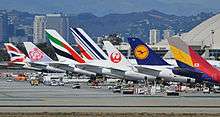
.jpg)
.jpg)
.jpg)
.jpg)


.jpg)
.jpg)
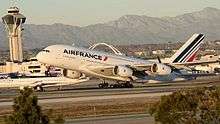
.jpg)
.jpg)
.jpg)
.jpg)
%2C_PH-BFE_-_LAX_(18294405380).jpg)
.jpg)
.jpg)
.jpg)
.jpg)
.jpg)
Notes:
- ^1 Qantas also flies to/from New York–JFK, but only for international, connecting traffic. The airline cannot transport passengers solely between LAX and JFK.
- ^2 Southwest Airlines international arrivals are processed at Terminal 2.
- ^3 Virgin America international arrivals are processed at Terminal 2.
- ^4 Virgin Australia check in is located in Terminal 3.
Cargo
Traffic and statistics
LAX handles more "origin and destination" (not connecting) passengers than any other airport in the world.[86][87]
The airport handled 28,861,477 enplanements, the total number of passengers boarding an aircraft, in 2008. This makes LAX the third busiest airport in the United States in terms of enplanements.[88]
It is the world's fifth-busiest airport by passenger traffic[89] and fifteenth-busiest by cargo traffic,[90] serving over 70.6 million passengers and 2 million tons of freight and mail in 2014. It is the busiest airport in the state of California, and the second-busiest airport by passenger boardings in the United States, based on final 2013 statistics.[91]
In terms of international passengers, as of 2012, LAX is the third busiest in the United States. (behind JFK in New York City and MIA in Miami)[92] and, as of 2006, 26th worldwide.[93]
The number of aircraft operations (landings and takeoffs) has steadily increased to 636,706 in 2014, up from 614,917 in 2013, according to the Federal Aviation Administration.[94] The Airports Council International places LAX at third most aircraft movements in the world, as of 2013.[95]
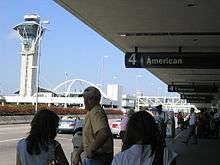
| Enplaned and Deplaned Passengers | Aircraft movements | Freight (tons) | Mail (tons) | |
|---|---|---|---|---|
| 1994 | 51,050,275 | 689,888 | 1,516,567 | 186,878 |
| 1995 | 53,909,223 | 732,639 | 1,567,248 | 193,747 |
| 1996 | 57,974,559 | 763,866 | 1,696,663 | 194,091 |
| 1997 | 60,142,588 | 781,492 | 1,852,487 | 212,410 |
| 1998 | 61,215,712 | 773,569 | 1,787,400 | 264,473 |
| 1999 | 64,279,571 | 779,150 | 1,884,526 | 253,695 |
| 2000 | 67,303,182 | 783,433 | 2,002,614 | 246,538 |
| 2001 | 61,606,204 | 738,433 | 1,779,065 | 162,629 |
| 2002 | 56,223,843 | 645,424 | 1,869,932 | 92,422 |
| 2003 | 54,982,838 | 622,378 | 1,924,883 | 97,193 |
| 2004 | 60,704,568 | 655,097 | 2,022,911 | 92,402 |
| 2005 | 61,489,398 | 650,629 | 2,048,817 | 88,371 |
| 2006 | 61,041,066 | 656,842 | 2,022,687 | 80,395 |
| 2007 | 62,438,583 | 680,954 | 2,010,820 | 66,707 |
| 2008 | 59,815,646 | 622,506 | 1,723,038 | 73,505 |
| 2009 | 56,520,843 | 544,833 | 1,599,782 | 64,073 |
| 2010 | 59,069,409 | 575,835 | 1,852,791 | 74,034 |
| 2011 | 61,862,052 | 603,912 | 1,789,204 | 80,442 |
| 2012 | 63,688,121 | 605,480 | 1,867,155 | 88,438 |
| 2013 | 66,667,619 | 614,917 | 1,848,764 | 77,286 |
| 2014 | 70,662,212 | 636,706 | 1,921,302 | 79,850 |
| 2015 | 74,936,256 | 655,564 | 2,038,221 | 94,265 |
| Source: Los Angeles World Airports[96] | ||||
Top domestic destinations
| Rank | Airport | Passengers | Carriers |
|---|---|---|---|
| 1 | San Francisco, California | 1,834,000 | American, Delta, Southwest, United, Virgin America |
| 2 | New York–JFK, New York | 1,655,000 | American, Delta, JetBlue, United, Virgin America |
| 3 | Chicago–O'Hare, Illinois | 1,399,000 | American, Frontier, Spirit, United, Virgin America |
| 4 | Las Vegas, Nevada | 1,337,000 | American, Delta, Southwest, Spirit, United, Virgin America |
| 5 | Seattle/Tacoma, Washington | 1,234,000 | Alaska, American, Delta, Spirit, United, Virgin America |
| 6 | Dallas/Fort Worth, Texas | 1,178,000 | American, Delta, Spirit, United |
| 7 | Atlanta, Georgia | 1,070,000 | American, Delta, Frontier, Southwest, Spirit |
| 8 | Honolulu, Hawaii | 1,070,000 | Allegiant, American, Delta, Hawaiian, United, Virgin America |
| 9 | Denver, Colorado | 1,033,000 | American, Delta, Frontier, Spirit, Southwest, United |
| 10 | Phoenix–Sky Harbor, Arizona | 904,000 | American, Delta, Southwest, Spirit, United, US Airways |
Top international destinations
| Rank | Airport | Passengers | Change 2014/2015 | Carriers |
|---|---|---|---|---|
| 1 | London (Heathrow), United Kingdom | 1,493,010 | |
Air New Zealand, American, British Airways, Delta, United, Virgin Atlantic |
| 2 | Tokyo (Narita), Japan | 1,102,172 | |
ANA, American, Delta, Japan Airlines, Singapore Airlines, United |
| 3 | Seoul (Incheon), South Korea | 1,083,522 | |
Asiana, Korean Air, Thai Airways |
| 4 | Taipei (Taoyuan), Taiwan | 946,426 | |
China Airlines, EVA Air |
| 5 | Sydney, Australia | 934,215 | |
American, Delta, Qantas, United, Virgin Australia |
| 6 | Vancouver, Canada | 896,490 | |
Air Canada, Alaska, American, Delta, United, WestJet |
| 7 | Guadalajara, Mexico | 746,017 | |
Aeroméxico, Alaska, American, Delta, Interjet, Volaris |
| 8 | Mexico City, Mexico | 725,575 | |
Aeroméxico, American, United, Volaris |
| 9 | Toronto (Pearson), Canada | 619,227 | |
Air Canada, American |
| 10 | Paris (Charles de Gaulle), France | 579,311 | |
Air France, Air Tahiti Nui |
| 11 | Hong Kong, Hong Kong | 553,214 | |
Cathay Pacific |
| 12 | Shanghai (Pudong), China | 512,456 | |
American, China Eastern, Delta, United |
| 13 | Dubai (International), United Arab Emirates | 486,975 | |
Emirates |
| 14 | Beijing (Capital), China | 464,832 | |
Air China |
| 15 | Melbourne, Australia | 445,525 | |
Qantas, United |
Airline market share
| Rank | Airline | Passengers | Share |
|---|---|---|---|
| 1 | American Airlines1 | 11,230,000 | 20.30% |
| 2 | Delta Air Lines | 9,369,000 | 16.94% |
| 3 | Southwest Airlines | 8,944,000 | 16.17% |
| 4 | United Airlines | 8,412,000 | 15.21% |
| 5 | SkyWest Airlines | 2,725,000 | 4.93% |
- Notes
- ^1 Includes US Airways
Ground transportation
Transportation between terminals
Shuttles operate to and from the terminals, providing frequent service for connecting passengers. However, connecting passengers who use these shuttles must leave and then later reenter security. Underground tunnels connect between terminals 4, 5, 6, 7, and 8, and an above-ground connector between TBIT and terminal 4 opened in February 2016.[99]
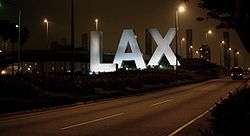
Freeways and roads
LAX's terminals are immediately west of the interchange between Century Boulevard and Sepulveda Boulevard (State Route 1). The 405 Freeway can be reached to the east via Century Boulevard, and the 105 Freeway can be reached to the south via Sepulveda Boulevard.
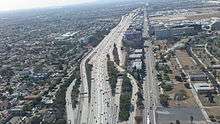
Bus
The closest bus stops to the terminals are the pair of opposites on Sepulveda Boulevard and Century Boulevard, served by Metro 117, Torrance 8, Metro 232, Commuter Express 574 and Metro 40 to Los Angeles Union Station (owl service only).
In addition, out of a number of bus systems, many routes (local, rapid and express) of the LACMTA Metro 232 to Long Beach, Line 8 of Torrance Transit, Line 109 of Beach Cities Transit, the Santa Monica Big Blue Bus system's Line 3 and Rapid 3 via Lincoln Boulevard to Santa Monica and the Culver CityBus's Line 6 and Rapid 6 via Sepulveda Blvd to Culver City and UCLA all make stops at the LAX Transit Center in Parking Lot C. on 96th St., where shuttle bus "C" offers free connections to and from every LAX terminal, and at the Green Line, where shuttle bus "G" connects to and from the terminals.
The Taiwanese airline China Airlines operates a bus service from LAX to Monterey Park and Rowland Heights. This service is only available for China Airlines customers.[100]
FlyAway Bus
The FlyAway Bus is a nonstop motorcoach/shuttle service run by the LAWA, which provides scheduled service between LAX and Downtown Los Angeles, the San Fernando Valley (Van Nuys), West Los Angeles (Westwood), Hollywood and Santa Monica. The Irvine FlyAway was discontinued on August 31, 2012. The shuttle service stops at every LAX terminal. The service hours vary based on the line. All lines use the regional system of High Occupancy Vehicle lanes to expedite their trips. The Los Angeles Union Station service and a late-night branch of Metro Local route 40 are the only direct transport links between the airport and Downtown Los Angeles.
Metro Rail
Shuttle bus "G" offers a free connection to and from the Aviation/LAX station on the Los Angeles Metro Rail Green Line. The line was originally intended to connect directly to the airport terminals, but budgetary restraints and opposition from local taxi and parking lot owners impeded its progress and won.
Airport Metro Connector
Airport Metro Connector | |||||||||||||||||||||||||||||||||||||||||||||||||||||||||||||||
|---|---|---|---|---|---|---|---|---|---|---|---|---|---|---|---|---|---|---|---|---|---|---|---|---|---|---|---|---|---|---|---|---|---|---|---|---|---|---|---|---|---|---|---|---|---|---|---|---|---|---|---|---|---|---|---|---|---|---|---|---|---|---|---|
Legend | |||||||||||||||||||||||||||||||||||||||||||||||||||||||||||||||
| |||||||||||||||||||||||||||||||||||||||||||||||||||||||||||||||
In June 2014, the Los Angeles County Metropolitan Transportation Authority approved a $200 million Metro Rail infill station called Aviation/96th Street on the under construction Crenshaw/LAX Line to connect to an automated people mover (APM) system called the Airport Metro Connector, connecting terminals 1–8 to the light rail systems.[101] The people mover will have six stations: three serving the central terminal area, one serving a ground transportation hub, one serving the infill light rail station, and one serving a rental car hub, decreasing the need for shuttle bus services. Construction, estimated to cost $1.5 billion, is planned to start in early 2017 and to be completed by early 2024.[102][103] Currently, shuttle bus "G" runs every 10–15 minutes (synched with the train schedule) from 5 am – 1:30 am.[104]
Taxis and private shuttles
Taxicab services are operated by nine city-authorized taxi companies and regulated by Authorized Taxicab Supervision Inc. (ATS). ATS maintains a taxicab holding lot under the 96th Street Bridge where, at peak periods, hundreds of cabs queue up to wait their turn to pull into the central terminal area to pick up passengers. A number of private shuttle companies also offer limousine and bus services to LAX Airport.
Coast Guard Air Station Los Angeles
The airport also functions as a joint civil-military facility, providing a base for the United States Coast Guard and its Coast Guard Air Station Los Angeles facility, operating four HH-65 Dolphin helicopters, which covers Coast Guard operations in various Southern California locations, including Catalina Island. Missions include search and rescue (SAR), law enforcement, aids to navigation support (such as operating lighthouses) and various military operations. In addition, Coast Guard helicopters assigned to the air station deploy to Coast Guard cutters.
The Coast Guard is planning to close Coast Coast Guard Air Station Los Angeles and move its aircraft and personnel to Naval Air Station Point Mugu, part of Naval Base Ventura County in Oxnard, California, when the lease on the existing facility ends in 2016.[105][106]
Flight Path Learning Center & Museum
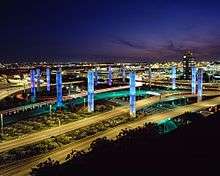
The Flight Path Learning Center is a museum located at 6661 Imperial Highway and was formerly known as the "West Imperial Terminal". This building used to house some charter flights (Condor Airlines) and regular scheduled flights by MGM Grand Air. It sat empty for 10 years until it was re-opened as a learning center for LAX.
The center contains information on the history of aviation, several pictures of the airport, as well as aircraft scale models, flight attendant uniforms, and general airline memorabilia such as playing cards, china, magazines, signs, even a TWA gate information sign. The museum also offers school tours and a guest speaker program.
The museum's library contains an extensive collection of rare items such as aircraft manufacturer company newsletters/magazines, technical manuals for both military and civilian aircraft, industry magazines dating back to World War II and before, historic photographs and other invaluable references on aircraft operation and manufacturing.[107]
The museum has on display "The Spirit of Seventy-Six," which is a DC-3 (DC-3-262, Serial No. 3269). After being in commercial airline service, the plane served as a corporate aircraft for Union Oil Company for 32 years. The plane was built in the Douglas Aircraft Company plant in Santa Monica in January 1941, which was a major producer of both commercial and military aircraft.[108]
The museum claims to be "the only aviation museum and research center situated at a major airport and the only facility with a primary emphasis on contributions of civil aviation to the history and development of Southern California".[109] There are other museums at major airports, however, including the Udvar-Hazy Center of the National Air and Space Museum adjacent to Washington Dulles Airport, the Royal Thai Air Force Museum at Don Muang Airport, the Suomen ilmailumuseo (Finnish Aviation Museum) at Helsinki-Vantaa Airport, the Frontiers of Flight Museum at Dallas Love Field, the Tulsa Air and Space Museum & Planetarium at Tulsa International Airport and others.
Other facilities
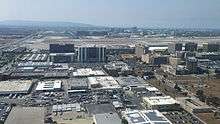
The airport has the administrative offices of Los Angeles World Airports.[110]
Continental Airlines once had its corporate headquarters on the airport property. At a 1962 press conference in the office of Mayor of Los Angeles Sam Yorty, Continental Airlines announced that it planned to move its headquarters to Los Angeles in July 1963.[111] In 1963 Continental Airlines headquarters moved to a two-story, $2.3 million building on the grounds of the airport.[112][113] The July 2009 Continental Magazine issue stated that the move "underlined Continental Airlines western and Pacific orientation".[114] On July 1, 1983 the airline's headquarters were relocated to the America Tower in the Neartown area of Houston.[115]
In addition to Continental Airlines, Western Airlines and Flying Tiger Line also had their headquarters at LAX.[116][117]
Accidents and incidents
During its history there have been numerous incidents, but only the most notable are summarized below:[118]
1930s
- On January 23, 1939, the sole prototype Douglas 7B twin-engine attack bomber, designed and built as a company project, suffered loss of vertical fin and rudder during demonstration flight over Mines Field, flat spun into the parking lot of North American Aviation, burned. Another source states that the test pilot, in an attempt to impress the Gallic passenger, attempted a snap roll at low altitude with one engine feathered, resulting in the fatal spin.[119] Douglas test pilot Johnny Cable bailed out at 300 feet, chute unfurled but did not have time to deploy, killed on impact, flight engineer John Parks rode the airframe in and died, but 33-year-old French Air Force Capt. Paul Chemidlin, riding in aft fuselage near top turret, survived with broken leg, severe back injuries, slight concussion. Presence of Chemidlin, a representative of foreign purchasing mission, caused a furor in Congress by isolationists over neutrality and export laws. Type was developed as Douglas DB-7.[120]
1940s
- On June 1, 1940, the first Douglas R3D-1 for the U.S. Navy, BuNo 1901, crashed at Mines Field, before delivery. The Navy later acquired the privately owned DC-5 prototype, from William E. Boeing as a replacement.[121]
- On November 20, 1940, the prototype NA-73X Mustang, NX19998,[122] first flown October 26, 1940, by test pilot Vance Breese, crashed this date.[123] According to P-51 designer Edgar Schmued, the NA-73 was lost because test pilot Paul Balfour refused, before a high-speed test run, to go through the takeoff and flight test procedure with Schmued while the aircraft was on the ground, claiming "one airplane was like another". After making two high speed passes over Mines Field, he forgot to put the fuel valve on "reserve" and during third pass ran out of fuel. Emergency landing in a freshly plowed field caused wheels to dig in, aircraft flipped over, airframe was not rebuilt, the second aircraft being used for subsequent testing.[124]
- On October 26, 1944, WASP pilot Gertrude Tompkins Silver of the 601st Ferrying Squadron, 5th Ferrying Group, Love Field, Dallas, Texas, departed Los Angeles Airport, in North American P-51D Mustang, 44-15669,[125] at 1600 hrs PWT, headed for the East Coast. She took off into the wind, into an offshore fog bank, and was expected that night at Palm Springs. She never arrived. Due to a paperwork foul-up, a search did not get under way for several days, and while the eventual search of land and sea was massive, it failed to find a trace of Silver or her plane. She is the only missing WASP pilot. She had married Sgt. Henry Silver one month before her disappearance.[126]
1960s
- On January 13, 1969, a Scandinavian Airlines System Douglas DC-8-62, Flight 933, crashed into Santa Monica Bay, approximately 6 nautical miles (11 km) west of LAX at 7:21 pm, local time. The aircraft was operating as flight SK-933, nearing the completion of a flight from Seattle. Of nine crewmembers, three lost their lives to drowning, while 12 of the 36 passengers also drowned.
- On January 18, 1969, United Airlines Flight 266 a Boeing 727-200 bearing the registration number N7434U, crashed into Santa Monica Bay approximately 11.3 miles (18.2 km) west of LAX at 6:21 pm local time. The aircraft was destroyed, resulting in the loss of all 32 passengers and six crew members aboard.
1970s
- On the evening of June 6, 1971, Hughes Airwest Flight 706, a Douglas DC-9 jetliner that had departed LAX on a flight to Salt Lake City, Utah, was struck nine minutes after takeoff by a U.S. Marine Corps McDonnell Douglas F-4 Phantom II fighter jet over the San Gabriel Mountains. The midair collision killed all 44 passengers and five crew members aboard the DC-9 airliner and one of two crewmen aboard the military jet.
- On August 6, 1974, a bomb exploded near the Pan Am ticketing area at Terminal 2; three people were killed and 35 were injured.[127]
- On March 1, 1978, two tires burst in succession on a McDonnell Douglas DC-10-10 on Continental Airlines Flight 603 during its takeoff roll at LAX and the plane, bound for Honolulu, veered off the runway. A third tire burst and the DC-10's left landing gear collapsed, causing a fuel tank to rupture. Following the aborted takeoff, spilled fuel ignited and enveloped the center portion of the aircraft in flames. During the ensuing emergency evacuation, a husband and wife died when they exited the passenger cabin onto the wing and dropped down directly into the flames. Two additional passengers died of their injuries approximately three months after the accident; 74 others aboard the plane were injured, as were 11 firemen battling the fire.
- On the evening of March 10, 1979, Swift Aire Flight 235, a twin-engine Aerospatiale Nord 262A-33 turboprop en route to Santa Maria, was forced to ditch in Santa Monica Bay after experiencing engine problems upon takeoff from LAX. The pilot, co-pilot and a female passenger drowned when they were unable to exit the aircraft after the ditching. The female flight attendant and the three remaining passengers—two men and a pregnant woman—survived and were rescued by several pleasure boats and other watercraft in the vicinity.
1980s
- On August 31, 1986, Aeroméxico Flight 498, a DC-9 en route from Mexico City, Mexico to Los Angeles, began its descent into LAX when a Piper Cherokee collided with the DC-9's left horizontal stabilizer over Cerritos, California, causing the DC-9 to crash into a residential neighborhood. All 67 people on the two aircraft were killed, in addition to 15 people on the ground. 5 homes were destroyed and an additional 7 were damaged by the crash and resulting fire. The Piper went down in a nearby schoolyard and caused no further injuries on the ground. As a result of this incident, the FAA required all commercial aircraft to be equipped with Traffic Collision Avoidance System (TCAS).
1990s
- On February 1, 1991, USAir Flight 1493 (arriving from Columbus, Ohio), a Boeing 737-300, landing on runway 24L at LAX, collided on touchdown with a SkyWest Airlines Fairchild Metroliner, Flight 5569 departing to Palmdale, California. The Skywest plane was given clearance to wait on the runway for takeoff. The same controller then gave the USAir plane clearance to land on the same runway, forgetting that the SkyWest plane was there. The collision killed all 12 occupants of the SkyWest plane and 22 people aboard the USAir 737.[128][129]
2000s
- Al-Qaeda attempted to bomb LAX on New Year's Eve 1999/2000. The bomber, Algerian Ahmed Ressam, was captured in Port Angeles, Washington, the U.S. port of entry, with a cache of explosives that could have produced a blast 40 times greater than that of a car bomb hidden in the trunk of the rented car in which he had traveled from Canada.[130][131] He had planned to leave one or two suitcases filled with explosives in an LAX passenger waiting area.[132][133] He was initially sentenced to 22 years in prison, but in February 2010 an appellate court ordered that his sentence be extended.[134]
- On January 31, 2000, Alaska Airlines Flight 261, a McDonnell Douglas MD-83 jetliner flying from Puerto Vallarta, Mexico to San Francisco and Seattle, requested to make an emergency landing at LAX after experiencing control problems with its tail-mounted horizontal stabilizer. Before the plane could divert to Los Angeles, it suddenly plummeted into the Pacific Ocean approximately 2.7 miles (4.3 km) north of Anacapa Island off the California coast, killing all 88 people aboard the aircraft.[135]
- Three of the aircraft hijacked as part of the September 11, 2001 attacks (American Airlines Flight 11, American Airlines Flight 77, and United Airlines Flight 175) were scheduled services to LAX.
- In the 2002 Los Angeles International Airport shooting of July 4, 2002, Hesham Mohamed Hadayet killed two Israelis at the ticket counter of El Al Airlines at LAX. Although the gunman was not linked to any terrorist group, the man was upset at U.S. support for Israel, and therefore was motivated by political disagreement. This led the FBI to classify this shooting as a terrorist act,[136] one of the few on U.S. soil since the September 11 attacks.
- On September 21, 2005, JetBlue Flight 292, an Airbus A320 discovered a problem with its landing gear as it took off from Bob Hope Airport in Burbank, California. It flew in circles for three hours to burn off fuel, then landed safely at Los Angeles International Airport on runway 25L, balancing on its back wheels as it rolled down the center of the runway. Passengers were able to watch their own coverage live from the satellite broadcast on JetBlue in-flight TV seat displays of their plane as it made an emergency landing with the front landing gear visibly becoming damaged. Because JetBlue did not serve LAX at the time, the aircraft was evaluated and repaired at a Continental Airlines hangar.[137][138]
- On July 29, 2006, after America West Express Flight 6008, a Canadair Regional Jet operated by Mesa Airlines from Phoenix, Arizona, landed on runway 25L, controllers instructed the pilot to leave the runway on a taxiway known as "Mike" and stop short of runway 25R. Even though the pilot read back the instructions correctly, he accidentally taxied onto 25R and into the path of a departing SkyWest Airlines Embraer EMB-120 operating United Express Flight 6037 to Monterey, California. They cleared each other by 50 feet (15 m) and nobody was hurt.[139]
- On August 16, 2007, a runway incursion occurred between WestJet Flight 900 and Northwest Airlines Flight 180 on runways 24R and 24L, respectively, with the aircraft coming within 37 feet (11 m) of each other. The planes were carrying a combined total of 296 people, none of whom were injured. The NTSB concluded that the incursion was the result of controller error.[140] In September 2007, FAA Administrator Marion Blakey stressed the need for LAX to increase lateral separation between its pair of north runways in order to preserve the safety and efficiency of the airport.[141]
2010s
- On October 13 and 14, 2013, two incidents of dry ice bomb explosions occurred at the airport. The first dry ice bomb exploded at 7:00 p.m. in an employee restroom in Terminal 2, injuring nobody. Terminal 2 was briefly shut down as a result. On the next day at 8:30 p.m., a dry ice bomb exploded on the ramp area near the Tom Bradley International Terminal, injuring nobody. Two other plastic bottles containing dry ice were found at the scene during the second explosion. On October 15, a 28-year-old airport employee was arrested in connection with the explosions and was booked on charges of possession of an explosive or destructive device near an aircraft. He is currently held on a $1 million bail.[142][143][144] On October 18, a 41-year-old airport employee was arrested in connection with the second explosion, and was booked on suspicion of possessing a destructive device near an aircraft.[145] Authorities believe that the incidents are not linked to terrorism.[142]
- In the 2013 Los Angeles International Airport shooting of November 1, 2013, at around 9:31 a.m. PDT, a lone gunman entered Terminal 3 and opened fire with a semi-automatic rifle, killing a Transportation Security Administration (TSA) officer and wounding three other people. The gunman was later apprehended and taken into custody. Until the situation was clarified and under control, a few terminals at the airport were evacuated, all inbound flights were diverted and all outbound flights were grounded until the airport began returning to normal operation at around 2:30 p.m.[146][147]
- On August 28, 2016 there was a false report of shots fired throughout the airport, causing a temporary lock down and about 3 hours of flight delays.[148]
Planned modernization
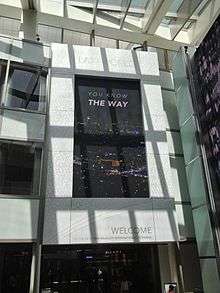
LAWA currently has several plans to modernize LAX. These include terminal and runway improvements, which will enhance the passenger experience, reduce overcrowding, and provide airport access to the latest class of very large passenger aircraft.
These improvements include:[149]
- New crossfield taxiway
- New large aircraft gates at TBIT
- TBIT core improvements
- New Midfield Satellite Concourse
- Replacement of Central Utility Plant
- Terminal and Runway Improvements
LAWA is also planning to build and operate an automated people mover. This small train will include three stations in the central terminal area and three outside east of the terminals at a new intermodal transportation facility, connecting passengers between the central terminal area and the Metro Green Line, the future Metro Crenshaw Line, and regional and local bus lines and a consolidated car rental facility.[150]
In popular culture
Numerous films and television shows have been set or filmed partially at LAX, at least partly due to the airport's proximity to Hollywood studios. Film shoots at the Los Angeles airports, including LAX, produced $590 million for the Los Angeles region from 2002 to 2005.[151]
See also
- California World War II Army Airfields
- List of airports in the Los Angeles area
- Metro
- Los Angeles Airport Police
- Peirson Mitchell Hall
References
- 1 2 "Cities served - Alaska Airlines". Newsroom - Alaska Airlines. Alaska Airlines. September 2016. Retrieved October 15, 2016.
With hubs in Anchorage, Alaska, Los Angeles and Portland, Oregon; Alaska calls Seattle home. The carrier offers more nonstop flights from Seattle than any other carrier.
- 1 2 "Delta Hub Station Los Angeles". January 12, 2016. Retrieved January 12, 2016.
- 1 2 "Los Angeles International airport – Economic and social impacts". Ecquants. Archived from the original on May 22, 2014. Retrieved September 7, 2013.
- ↑ FAA Airport Master Record for LAX (Form 5010 PDF). Retrieved March 15, 2007.
- ↑ "LAX Statistics – Passengers". Lawa.org. Retrieved April 25, 2016.
- ↑ "Statistics". Los Angeles World Airports. January 2016. Retrieved July 12, 2016.
- ↑ Daily Breeze (January 26, 2016). "LAX sets record for passenger volume in 2015". dailybreeze.com.
- ↑ "Airport Traffic Reports". Airports Council International – North America. Retrieved August 19, 2012.
- ↑ "Westfield at LAX". Archived from the original on January 27, 2014. Retrieved January 15, 2016.
- ↑ "Aviation Facilities Company, Inc. :: Properties :: LAX". Afcoinc.com. Archived from the original on July 7, 2011. Retrieved December 6, 2010.
- ↑ "LAX Early History". Los Angeles World Airports. Retrieved October 25, 2011.
- ↑ "LAX – Airport Information – General Description – Just the Facts". Lawa.org. Retrieved December 6, 2010.
- 1 2 "Search history". Los Angeles World Airports. Retrieved March 21, 2008.
- ↑ Official Guide of the Airways 7/40 and American Aviation Air Traffic Guide 1/46, 12/46 and 6/47
- ↑ "backwards 1939 aerial view". Digitallibrary.usc.edu. Retrieved August 13, 2013.
- ↑ "USC Libraries Digital Collections". Digitallibrary.usc.edu. Retrieved 2016-04-28.
- ↑ Airport diagrams for 1956 and 1965
- ↑ "LAX Frequently Asked Questions". Los Angeles World Airports. Retrieved January 28, 2010.
- ↑ "Space Shuttle Endeavour Comes Home to Los Angeles". Dryden Flight Research Center. September 21, 2012. Retrieved October 15, 2012.
- ↑ Eddie Sotto (August 6, 2001). "Encounter at the Theme Building". LaughingPlace.com (Interview). Interview with Marc Borrelli. Retrieved February 25, 2008.
- ↑ "Iconic LAX Theme Building ready for its close-up". KPCC. July 2, 2010. Retrieved July 2, 2010.
- ↑ "Art Program – LAX 9/11 Memorial". Lawa.org. September 11, 2001. Retrieved August 13, 2013.
- ↑ "Mayor Villaraigosa Announces New Qantas Maintenance Facility at LAX". Business Wire. February 1, 2006. Retrieved April 3, 2008.
- ↑ routesonline.com - Air Berlin expands US flights in S17 3 August 2016
- ↑ "Alaska Airlines will fly to Havana, Cuba, beginning Jan. 5, 2017" (Press release). Alaska Airlines. September 27, 2016. Retrieved September 27, 2016.
- ↑ "2016 Los Angeles-Beijing Frequency Allocation Proceeding — Docket DOT-OST-2016-0076" (PDF) (Press release). Washington, D.C.: Airline Information Research, Inc. United States of America Department of Transportation. 2016-11-07. Archived (PDF) from the original on 2016-11-07. Retrieved 2016-11-07.
- 1 2 "American adds new Los Angeles – Mexico routes from mid-Dec 2016". routesonline. Retrieved August 14, 2016.
- ↑ "American Airlines to stop nonstop service from Pittsburgh to Los Angeles". Tribune Live. Tribune Live. Retrieved 22 November 2016.
- ↑ "American adds seasonal LAX – Grand Junction route in S17". routesonline. Retrieved 11 October 2016.
- ↑ Austrian Airlines (16 September 2016). "Austrian Airlines Initiates Flight Service to Los Angeles". Retrieved 16 September 2016.
- ↑ "Delta Air Lines plans three new transborder routes to Mexico". ATWOnline - Air Transport World.
- ↑ http://www.usatoday.com/story/travel/flights/todayinthesky/2016/10/10/delta-offer-lie-flat-seats-new-washington-national-lax-route/91852726/
- ↑ "DELTA Adds Los Angeles – Aspen Service from Dec 2016". airlineroute. Retrieved February 22, 2016.
- ↑ http://www.cleveland.com/travel/index.ssf/2016/10/frontier_airlines_cuts_service.html
- ↑ http://www.usatoday.com/story/travel/flights/todayinthesky/2016/09/26/jetblue-adds-new-cross-country-route-los-angeles/91114750/
- ↑ http://www.routesonline.com/news/38/airlineroute/269190/lot-adds-los-angeles-service-from-april-2017/
- ↑ http://www.usatoday.com/story/travel/flights/todayinthesky/2016/09/07/norwegian-air-fly-spain-four-us-cities/89962580/
- ↑ "Sichuan adds Jinan – Los Angeles service from Dec 2016". routesonline. Retrieved 1 November 2016.
- ↑ Airlines, Singapore. "SIA To Expand U.S. Operations With Non-Stop San Francisco Flights And Second Daily Los Angeles Service". PR Newswire.
- 1 2 3 2016, UBM (UK) Ltd. "Southwest schedules new Los Angeles – Mexico routes from Dec 2016". routesonline.
- ↑ http://blog.virginaustralia.com/news-and-updates/melbourne-los-angeles-and-perth-abu-dhabi-flights
- ↑ "Our Stations « AeroUnion". AeroUnion. Retrieved April 25, 2016.
- ↑ "News Content". Lawa.org. Retrieved April 25, 2016.
- ↑ "Air China Cargo Co., Ltd". Air China Cargo. Retrieved April 25, 2016.
- ↑ "Air China Cargo Co., Ltd". Air China Cargo. Retrieved April 25, 2016.
- 1 2 "Aloha Air Cargo leasing an ABX Air freighter for LAX flights". ch-aviation. Retrieved April 25, 2016.
- ↑ "Welcome To Asiana Cargo". Asiana Cargo.
- ↑ "CARGOLUX AIRLINE Los Angeles CA, 90045 – Cortera Company Profile". Cortera. Retrieved April 25, 2016.
- ↑ "Cargolux Airlines International". Airport-LA. Retrieved April 25, 2016.
- ↑ "Network – Cathay Pacific Cargo". Cathay Pacific Cargo. Retrieved April 25, 2016.
- ↑ "Cathay Pacific expands cargo presence in the Americas with new freighter service to Portland". Cathay Pacific.
- ↑ "Centurion Cargo". Centurion Air Cargo.
- ↑ "China Airlines Cargo Services". China Airlines. Retrieved April 25, 2016.
- ↑ "China Airlines Cargo Services". China Airlines. Retrieved April 25, 2016.
- ↑ "China Airlines Service". China Airlines Cargo.
- ↑ "China Cargo Airlines in Los Angeles , CA". Yellow Pages.
- ↑ "China Southern Airline Cargo". Citysearch. Retrieved April 25, 2016.
- ↑ "Cargo-China Southern Airlines Co. Ltd csair.com". China Southern Airlines. Retrieved April 25, 2016.
- ↑ "China Southern Cargo". Sky Team Cargo. Archived from the original on September 24, 2015.
- ↑ Station Search
- ↑ "Atlas Air Worldwide Holdings". Atlasair.com. 2015-09-18. Retrieved 2016-04-28.
- ↑ "Archived copy" (PDF). Archived from the original (PDF) on November 19, 2015. Retrieved November 19, 2015.
- ↑ "Polar Air Cargo". Polar Air Cargo. 2015-09-18. Retrieved 2016-04-28.
- ↑ "Polar Air Cargo". Polar Air Cargo. 2015-09-18. Retrieved 2016-04-28.
- ↑ "Polar Air Cargo" (PDF). Polaraircargo.com. 2015-09-18. Retrieved 2016-04-28.
- ↑ "Media". Emirates SkyCargo. Retrieved April 25, 2016.
- ↑ "A-Z Air Freighters Guide – Emirates SkyCargo (EK/UAE/176)". Azfreighters.com. Retrieved April 25, 2016.
- ↑ "EVA Air Cargo". Eva Air Cargo. Retrieved April 25, 2016.
- ↑ "Florida West International Airways - World Airline News". World Airline News.
- ↑ "Korean Air cargo LAX 6101 W Imperial Hwy Los Angeles, CA Airline Companies". MapQuest. 2015-09-18. Retrieved 2016-04-28.
- ↑ "▒▒ Korean Air Cargo - To be a respected leader in the world airline community ▒▒". Cargo.koreanair.com. 2015-09-18. Retrieved 2016-04-28.
- ↑ "LUFTHANSA CARGO AG Los Angeles CA, 90045 – Cortera Company Profile". Cortera. April 25, 2016. Retrieved April 25, 2016.
- ↑ "Archived copy". Archived from the original on November 19, 2015. Retrieved November 19, 2015.
- ↑ "Statistical Data - Air Cargo - Chubu Centrair International Airport, Nagoya". Centrair.
- ↑ "NCA – Nippon Cargo Airlines – Contact Us". Nippon Cargo Airlines. Retrieved April 25, 2016.
- ↑ "NCA – Nippon Cargo Airlines – Flight Schedule". Nippon Cargo Airlines. Retrieved April 25, 2016.
- ↑ "Qantas : Los Angeles Freight Terminal : Restrictions" (PDF). Qantas.org. 2015-09-18. Retrieved 2016-04-28.
- ↑ "Archived copy". Archived from the original on March 2, 2015. Retrieved November 19, 2015.
- ↑ "Qatar Airways Cargo to launch service to Los Angeles". Air Logistics Group USA. July 6, 2013. Retrieved April 25, 2016.
- ↑ "Qatar Airways to launch freighter service to Los Angeles". joc.com. July 6, 2013. Retrieved April 25, 2016.
- ↑ "Qatar Airways Cargo to launch freighter services to LAX". L.A. Biz. March 18, 2015.
- ↑ "Singapore Airlines Cargo". Foursquare. July 6, 2013. Retrieved April 25, 2016.
- ↑ "Welcome to SIA Cargo - Worldwide Offices". Siacargo.com. 2015-09-18. Retrieved 2016-04-28.
- ↑ "Archived copy". Archived from the original on September 13, 2015. Retrieved November 19, 2015.
- ↑ "North Carolina's SkyLease Cargo applies for Hong Kong rights". ch-aviation. July 6, 2013. Retrieved April 25, 2016.
- ↑ "LAX Airport Information: General Information". Los Angeles World Airports. Retrieved November 18, 2010.
- ↑ Fine, Howard (November 26, 2001). "LAX Emerges As Worst U.S.: Airport Design Ill-Suited for New Security Screenings". Los Angeles Business Journal. Archived from the original on March 10, 2010. Retrieved September 26, 2010.
- ↑ "Calendar Year 2008 Commercial Service Airports Enplanement Statistics" (PDF). Federal Aviation Administration. Retrieved February 28, 2010.
- ↑ "Passenger Traffic 2006 FINAL". Airports Council International. July 18, 2007. Archived from the original on September 29, 2007. Retrieved February 24, 2008.
- ↑ "Cargo Traffic 2006 FINAL". Airports Council International. July 18, 2007. Archived from the original on September 29, 2007. Retrieved February 24, 2008.
- ↑ Passenger Traffic 2006 FINAL from Airports Council International Archived April 29, 2012, at the Wayback Machine.
- ↑ "U.S. International Travel and Transportation Trends, September 2006" (PDF). U.S. Department of Transportation, Research and Innovative Technology Administration, Bureau of Transportation Statistics. 2006. Retrieved February 24, 2008.
- ↑ "Year to date International Passenger Traffic". Airports Council International. July 12, 2010. Archived from the original on December 6, 2010. Retrieved July 23, 2010.
- ↑ "LOS ANGELES INTERNATIONAL AIRPORT REPORTS 2011 PASSENGER LEVEL UP 4.7 PERCENT OVER 2010; AIR CARGO DOWN 3.8 PERCENT". Los Angeles World Airports (Press release). January 24, 2012.
- ↑ "2013 final". Aci.aero. Retrieved April 25, 2016.
- ↑ "Airport Information – Statistics". Los Angeles World Airports. Retrieved February 12, 2015.
- 1 2 "RITA | BTS | Transtats". transtats.bts.gov. Retrieved June 2016. Check date values in:
|access-date=(help) - ↑ "BTS Air Carriers : T-100 International Market (All Carriers)". Retrieved June 16, 2016.
- ↑ Nguyen, John (February 25, 2015). "LAX Just Got Better: Airside Connector to International Terminal Opens (Video)". Airline Reporter. Retrieved April 10, 2016.
- ↑ "Airport Shuttle Bus". China Airlines. 2016-03-15. Retrieved 2016-04-28.
- ↑ "Airport Metro Connector" (PDF). LACMTA. August 2015. Retrieved February 2, 2016.
- ↑ Nelson, Laura J. (June 26, 2014). "Train station to connect Metro rail lines with LAX approved". Los Angeles Times. Retrieved May 25, 2015.
- ↑ Weikel, Dan. "Light rail plan for Los Angeles International Airport advances". LA Times. LA Times. Retrieved December 18, 2012.
- ↑ LAWA Contract Manager
- ↑ "Archived copy". Archived from the original on February 16, 2015. Retrieved February 16, 2015.
- ↑ "Coast Guard Air Station at LAX moving to Oxnard in 2016, which may bring some noise relief to South Bay". Daily Breeze. Retrieved April 25, 2016.
- ↑ Parker, Dana T. Building Victory: Aircraft Manufacturing in the Los Angeles Area in World War II, pp. 6, 17, 19, 26, 34, 48, 80, 91, 92, Cypress, CA, 2013. ISBN 978-0-9897906-0-4.
- ↑ Parker, Dana T. Building Victory: Aircraft Manufacturing in the Los Angeles Area in World War II, pp. 11-25, Cypress, CA, 2013. ISBN 978-0-9897906-0-4.
- ↑ "Flight Path Learning Center (official site)". Retrieved February 25, 2008.
- ↑ "About LAWA". Los Angeles World Airports. Retrieved on September 28, 2011. "Los Angeles International Airport 1 World Way, Los Angeles, CA 90045"
- ↑ "Continental Airlines to Move Its Main Offices Here From Denver". Los Angeles Times. August 16, 1962. B11. Retrieved on January 24, 2010.
- ↑ "AIRLINE OCCUPIES NEW HEADQUARTERS IN L.A." Los Angeles Times. September 15, 1963. Section J, page N6. Retrieved on January 24, 2010.
- ↑ "Westchester – Mapping L.A." Los Angeles Times. Retrieved on March 19, 2010.
- ↑ "The Company" (). Continental Airlines Magazine. July 2009. Retrieved on February 8, 2010.
- ↑ "Insurer to Buy Continental Stock". Associated Press at Toledo Blade. Wednesday March 16, 1983. Page 4. Google News 3 of 52. Retrieved on August 22, 2009.
- ↑ "World Airline Directory". Flight International. March 30, 1985. 131". Retrieved on June 17, 2009. "Head Office: PO Box 92005, World Way Postal Center, Los Angeles International Airport, Los Angeles 90009, United States".
- ↑ "World Airline Directory". Flight International. March 30, 1985. 83". Retrieved on July 23, 2009. "7401 World Way West, Los Angeles International Airport, California 90009, United States"
- ↑ All incidents listed here are in the Aviation Safety Network LAX database, unless otherwise noted.
- ↑ Huston, John W., Major General, USAF, Ret., editor, "American Airpower Comes of Age: General Henry H. "Hap" Arnold's World War II Diaries; Volume 1", Air University Press, Maxwell AFB, Alabama, January 2002, Library of Congress card number 2001041259, ISBN 1-58566-093-0, page 88.
- ↑ Matthews, Birch, "Cobra!: Bell Aircraft Corporation 1934–1946", Schiffer Publishing Limited, Atglen, Pennsylvania, 1996, Library of Congress card number 95-72357, ISBN 0-88740-911-3, pp.112–113.
- ↑ Swanborough, Gordon, and Bowers, Peter M., "United States Navy Aircraft since 1911", Naval Institute Press, Annapolis, Maryland, 1976, Library of Congress card number 90-60097, ISBN 978-0-87021-792-0, pp.487.
- ↑ Waag, Robert, "NA 73 – The Forgotten Mustang", Airpower, Granada Hills, California, November 1971, Volume 1, Number 2, p. 9.
- ↑ Editors, "Mustang", Airpower, Granada Hills, California, July 1985, Volume 15, Number 4, p. 12.
- ↑ Mizrahi, Joseph V., "Airmail", Wings, Granada Hills, California, December 1985, Volume 15, Number 6, p. 5.
- ↑ "October 1944 USAAF Stateside Accident Reports". Aviationarchaeology.com. Retrieved August 13, 2013.
- ↑ "P-51 Mustang". Ub88.org. Retrieved August 13, 2013.
- ↑ Jonathan B. Tucker (2000). Toxic Terror: Assessing Terrorist Use of Chemical and Biological Weapons. MIT Press. p. 77. ISBN 978-0-262-70071-9.
- ↑ http://lessonslearned.faa.gov/ll_main.cfm?TabID=3&LLID=55
- ↑ https://www.fss.aero/accident-reports/dvdfiles/US/1991-02-01-US.pdf
- ↑ U.S. Court of Appeals for the Ninth Circuit (February 2, 2010). "U.S. v. Ressam" (PDF). Retrieved February 27, 2010.
- ↑ "Complaint; U.S. v. Ressam" (PDF). NEFA Foundation. December 1999. Retrieved February 26, 2010.
- ↑ "Ressam Testimony in Mokhtar Haouari Trial". Southern District of New York. July 2001. Retrieved February 27, 2010.
- ↑ "Ahmed Ressam's Millennium Plot". Frontline. PBS. Retrieved February 28, 2010. [sic]
- ↑ "'Millennium bomber' sentence overturned; feds seek longer one – CNN.com". CNN. February 2, 2010. Retrieved May 11, 2010.
- ↑ "ASN Aircraft accident McDonnell Douglas MD-83 N963AS Anacapa Island, California". Aviation Safety Network. July 26, 2004. Retrieved March 13, 2008.
- ↑ Feldman, Charles (September 5, 2008). "Federal investigators: L.A. airport shooting a terrorist act". CNN.com. Archived from the original on February 1, 2008. Retrieved March 13, 2008.
- ↑ "ASN Aircraft accident Airbus A320-232 N536JB Los Angeles International Airport, California". Aviation Safety Network. October 7, 2005. Archived from the original on October 20, 2007. Retrieved March 13, 2008.
- ↑ Stuart, Pfeifer; Garvey, Megan; Morin, Monte (September 22, 2005). "Disabled Airliner Creates a 3-Hour Drama in Skies". Los Angeles Times. p. A1.
- ↑ "Third Annual Archie League Medal of Safety Award Winners: Michael Darling". NATCA. Archived from the original on July 2, 2007. Retrieved March 13, 2008.
- ↑ "NTSB incident report. NTSB identification OPS07IA009A". National Transportation Safety Board. Archived from the original on September 29, 2007. Retrieved March 13, 2008.
- ↑ Staff (September 2007). "Outgoing FAA Administrator Marion Blakey: LAX Must Address Runway Safety". Metro Investment Report. Archived from the original on July 20, 2011.
- 1 2 Alsup, Dave (October 16, 2013). "Police: Arrest made in Los Angeles airport dry ice explosion". CNN. Retrieved October 16, 2013.
- ↑ Abdollah, Tami (October 16, 2013). "AP Newsbreak: Arrest in LA airport ice explosions". Associated Press. Archived from the original on October 16, 2013. Retrieved October 16, 2013.
- ↑ Winton, Richard (October 16, 2013). "LAX dry ice explosions: Airport employee arrested in case". Los Angeles Times. Retrieved October 16, 2013.
- ↑ Abdollah, Tami (October 18, 2013). "Official: 2nd LAX worker also set off dry ice bomb". Associated Press. Archived from the original on October 19, 2013. Retrieved October 19, 2013.
- ↑ "TSA Agent Reported Shot at LAX; Major Police Response". KTLA TV. Retrieved November 1, 2013.
- ↑ "Passengers evacuated from terminal at Los Angeles International Airport after reports of gunshots". Fox News. Retrieved November 1, 2013.
- ↑ Helsel, Phil. "False Reports of Gunfire Cause Chaos at Los Angeles Airport". nbcnews.com. NBC News. Retrieved 29 August 2016.
- ↑ "LAX Specific Plan Amendment" (PDF). Retrieved December 6, 2010.
- ↑ "About the Flightglobal Group – Blogs Announcement – flightglobal.com". Flightglobal.com.
- ↑ Tony Barboza (January 22, 2007). "L.A. airports fly high with film shoots". Los Angeles Times.
Further reading
- Bullock, Freddy. LAX: Los Angeles International Airport (1998)
- Schoneberger, William A., Ethel Pattison, and Lee Nichols. Los Angeles International Airport (Arcadia Publishing, 2009.)
External links
| Wikivoyage has a travel guide for Los Angeles International Airport. |
| Wikimedia Commons has media related to Los Angeles International Airport. |
- Los Angeles International Airport official website
- LAneXt website
- LAX Noise Management Internet Flight Tracking System
- LAX Airport webcams, flight timetables & pilot data
- FAA Airport Diagram (PDF), effective November 10, 2016
-
 Los Angeles International Airport travel guide from Wikivoyage
Los Angeles International Airport travel guide from Wikivoyage - Resources for this airport:
- AirNav airport information for KLAX
- ASN accident history for LAX
- FlightAware airport information and live flight tracker
- NOAA/NWS latest weather observations
- SkyVector aeronautical chart for KLAX
- FAA current LAX delay information
 |
Playa del Rey | Westchester | Inglewood |  |
| Dockweiler State Beach and Pacific Ocean | |
Lennox | ||
| ||||
| | ||||
| Hyperion plant | El Segundo | Hawthorne |


